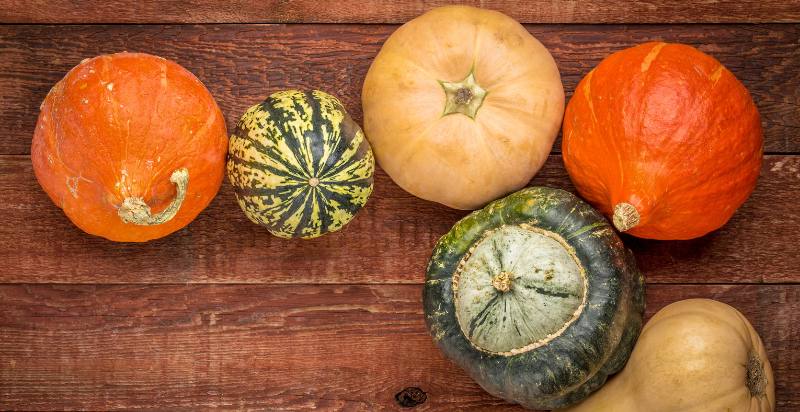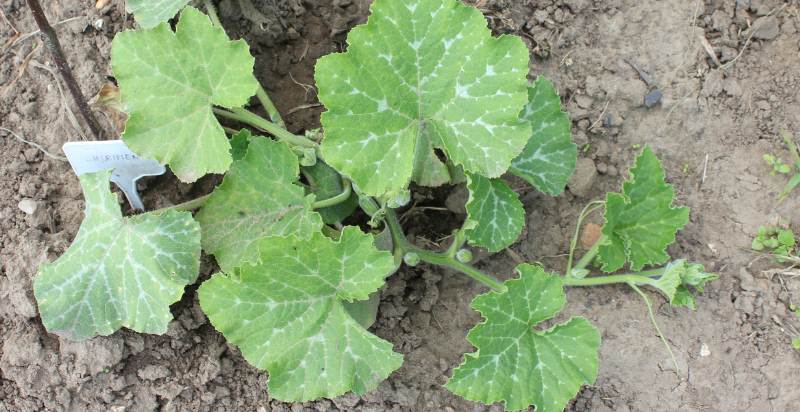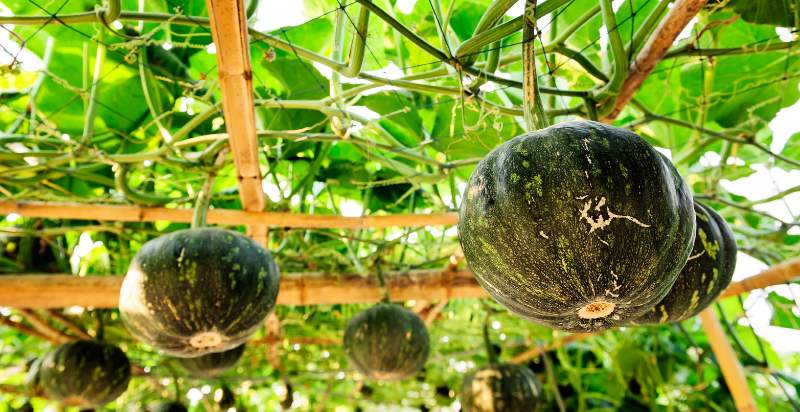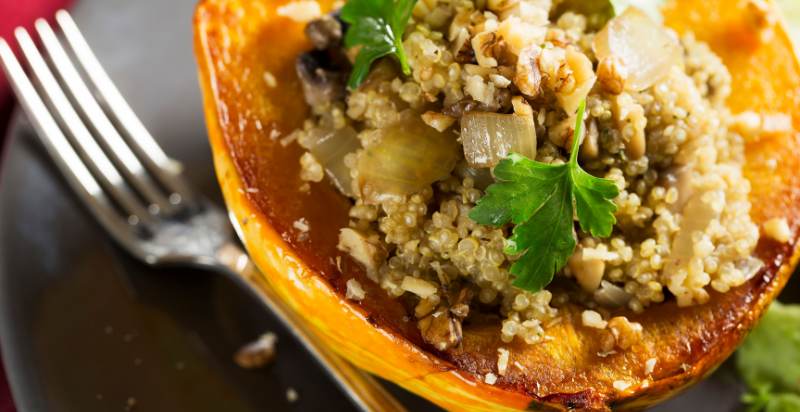Winter squash is a nutritious and versatile food that can be used in everything from soups to desserts. It’s an ancient crop that has been cultivated for centuries and remains popular today. Winter squash comes in many shapes and sizes and can be roasted, boiled, steamed, or pureed into soups or other dishes. It’s also a great source of fiber, vitamins A and C, potassium, manganese, magnesium, iron, zinc, and some B vitamins.
What is Winter squash?
Winter squash is a type of edible gourd native to the Americas. It’s an ancient crop, likely cultivated by Native Americans as early as 8,000 years ago. Winter squash is a member of the Cucurbitaceae family and other popular vegetables such as cucumbers and melons.
History and Origin of Winter Squash:
Winter squash is believed to be native to Central and South America, with evidence of its cultivation dating back at least 10,000 years. Ancient cultures such as the Aztecs and Incas developed many varieties of winter squash that are still grown and enjoyed today, including pumpkins, Hubbard squash, acorn squash, and delicata.
In North America, European settlers quickly adopted winter squash into their diets. Some scholars believe Native Americans taught them how to raise crops like this to survive the harsh winters. As the settlers moved further westward across North America they brought seeds for different types of winter squash with them.
Today winter squash has become a staple food in many parts of the world due to its versatility, flavor, and nutritional value. They contain vitamins and minerals such as vitamin A, beta-carotene, fiber, potassium, magnesium, iron, zinc, and manganese.
No matter how you prepare it, winter squash is a nutritious addition to any meal or snack that can easily replace your favorite starch. So next time you’re at the store, reach for some winter squash for a healthy and delicious treat.
Common Varieties of Winter Squash:
Wide varieties of winter squash are available in stores, including acorn, butternut, kabocha, Hubbard, and delicata. Acorn squash has dark green skin with deep ridges along its body and yellow-orange flesh inside. Butternut squash has light tan skin with orange flesh, while Kabocha squash looks like a small pumpkin with green and orange skin. Hubbard squash has thick, bumpy green skin with yellow-orange flesh and delicata squash is a long cylinder-shaped squash with pale yellow and green.

Nutrition in Winter Squash:
Winter squash is an incredibly nutritious vegetable with a high concentration of vitamins, minerals, and antioxidants. It contains dietary fiber to help keep your digestive system running smoothly and vitamin C for immune health. Winter squash is also a great source of potassium, magnesium, manganese, copper, and iron – all important for energy production in the body.
In addition to its nutrient-rich profile, winter squash is low in fat and calories. A cup of cooked butternut or acorn squash contains just 50-60 calories – making it an excellent choice if you’re trying to lose weight or maintain a healthy weight.
The bright orange color of winter squash comes from beta carotene – an antioxidant that is converted to vitamin A in the body. Vitamin A is important for vision, immune function, and healthy skin. Winter squash also contains lutein and zeaxanthin, two other antioxidants that protect your eyes from free radical damage.
Winter squash is a great addition to any diet as it can be prepared in various ways – roasted, steamed, pureed, or mashed into soups and casseroles. It’s also an excellent source of nutrients like dietary fiber and vitamin C – making it a great choice for those looking to boost their nutrition intake. So make sure you add some winter squash to your meals this season.
How to Plant Winter Squash?
Winter squash is a delightful addition to any garden. It’s easy to grow and provides a delicious harvest throughout the winter. This guide will discuss how to plant winter squash so you can enjoy its unique flavor year-round.
Planting Winter Squash:
When planting winter squash, selecting the right variety for your region is important. For example, if you live in colder climates, opt for varieties more tolerant of cooler temperatures, such as acorns or delicata squashes. If you live in warmer climates, look for varieties like butternut or Hubbard squashes which are better suited to warm weather conditions.
Once you have selected the ideal variety, choose an area of your garden with full sun and well-drained soil. Winter squash requires a lot of space, so ensure the area you choose is large enough to accommodate the plants when they mature.
Once you have chosen your spot, it’s time to plant your winter squash seeds. Planting can be done directly in the garden or started indoors in containers for later transplanting into the garden. If planting directly, sow two to three seeds about 1 inch deep into individual hills about 4-6 feet apart. When starting indoors, sow 2-3 seeds per pot 1/2 an inch deep and wait until after all danger of frost has passed before transplanting outdoors.
Care and Maintenance:
After planting your winter squash seeds, there are several things you can do to ensure a successful harvest. Be sure to provide your plants with plenty of water, especially during dry spells and in the early stages of growth. Winter squash will also benefit from regular fertilization, so use a balanced fertilizer throughout the growing season.
To help support the large squash fruit that winter squash produces, it’s important to provide sturdy trellises or other support structures for them. This will keep them off the ground and reduce the chance of rot, disease, or insect damage.
Harvesting Winter Squash:
When harvesting winter squash, wait until they’re fully mature before picking it, so you get the best flavor possible. Mature winter squash should have hard skins with dull colors and no soft spots. Harvest them with pruning shears or a sharp knife and store them in a cool, dry place for up to several months.
With these tips in mind, you’re ready to plant winter squash and enjoy its sweet taste throughout the winter months! So get out there and start planting – you won’t regret it!
How to Care for and Grow Winter Squash?
Winter squash is a nutritious, delicious, and versatile addition to the menu in fall and winter. It has a unique flavor that adds plenty of zest to soups, casseroles, and other dishes. To get the most out of your winter squash harvest, you need to know how to properly care for them from planting through harvesting.
When selecting squash plants for your garden, look for varieties that will grow well in your area, as some are more tolerant of cold temperatures than others. Plant squash seeds in well-draining soil after all danger of frost has passed; this usually occurs around April or May, depending on where you live. Sow two or three seeds about 1 inch deep and 4 inches apart. When the seedlings are one to two inches tall, thin them so that only the strongest remains. Space summer squash plants about 18 inches apart and winter squash 3 to 5 feet apart.
Keep your squash well-watered throughout the growing season. Water deeply once or twice a week when there is less than an inch of rain. Mulch with straw, grass clippings, or other organic matter around your plants will help keep weeds away and hold moisture in the soil.
Winter squash have long vines that need plenty of room to grow; provide support by driving wooden stakes into the ground near each plant. As soon as you see flowers on your winter squash, add liquid fertilizer containing phosphorus and potassium to the soil. This will help ensure better fruit production.
When harvesting your squash, leave about a 1-2 inch stem on each one to prevent rot from entering the fruit. Cut the squash off of the vine with pruning shears or a sharp knife, being careful not to damage the stems. Store winter squash in a cool, dry place at temperatures between 50 and 60 degrees Fahrenheit. They can keep for several months under ideal conditions.
With just a little care, you can enjoy an abundant harvest of winter squash that will add flavor and nutrition to your meals throughout the cooler months.

Preventions From Pests and Diseases:
Winter squash plants are generally resistant to many common problems but can still be prone to pests and diseases. To minimize your chances of dealing with these issues, practice crop rotation in your garden and make sure to remove any diseased foliage or insects from the area. Additionally, water at the base of your plants instead of over the leaves and remove any weeds that threaten to compete for resources.
If you notice any signs of disease or pests on your winter squash plants, treat them with a fungicide or insecticidal soap as soon as possible. This will help stop the spread and save your crop!
Finally, keep an eye out for common pests like cucumber beetles, aphids, and squash bugs which can all target your winter squash plants. If you spot any of these, use an insect trap or manually remove them by hand.
Following these tips and staying vigilant can help protect your winter squash crop from the many pests and diseases they may face. With a little extra effort, you’ll be able to harvest a plentiful crop that will keep you cozy throughout the winter.
How to Harvest Winter Squash?
Harvesting winter squash is a rewarding experience that can be done in many ways. The most important thing to remember when harvesting winter squash is to wait until the rinds are hard and the stems are dry. You should also ensure that you pick the fruits while they are still tender and slightly immature, as this will ensure they ripen off the vine properly.
When ready to harvest, use pruning shears or a sharp knife to cut away from the stem and leave at least 3 inches of stem attached to each squash. If the plant starts to wilt, it’s likely past its peak for harvesting – so act fast! For best results, harvest on a day with no rain, as wet squash will spoil more quickly.
When transporting the squash, handle them with care and never stack them on top of each other or allow them to bump against each other. Any damage done during transport can lead to rot and decay before you have a chance to enjoy it!
After Harvesting your Winter Squash:
- Store them in a cool, dark, and dry place for up to three months.
- Make sure there is plenty of air circulation around the squash for the best results.
- If you plan on eating your winter squashes within a month, keep them at room temperature or slightly above – temperatures below 55°F can cause the fruits to become mealy and not as flavorful.
With proper harvesting techniques, storage methods, and patience, your winter squashes will be a delicious addition to your dinner table.

How to Store Homegrown Winter Squash?
Storing homegrown winter squash is a great way to enjoy your harvest for months after it’s been harvested. Proper squash storage will ensure you have the best, most flavorful produce possible!
The first step in storing vegetables or fruits is selecting only the highest quality since a lower quality product will lead to spoilage and waste. Select a firm and free winter squash from soft spots, bruises, or mold. If they have stems attached, ensure they are still green and pliable.
Once you have chosen your favorite winter squash varieties, wash them off with cool water or use a vegetable brush to remove dirt and debris before placing them into storage bags or boxes. Make sure to dry them off completely before storing them. This will help the squash stay mold-free and prevent it from spoiling too quickly.
The next step is to find a suitable storage area for your winter squash. The ideal temperature should be between 50°F and 55°F, with a relative humidity of around 80%. It’s important to avoid extreme temperatures or large fluctuations in temperature, as this can lead to spoilage or disease. Avoid storing in direct sunlight, as this will cause the squash to overheat and become mushy. A basement, garage, or other cool areas are ideal for winter squash storage.
Once you have chosen the perfect spot for your winter squash, please place them in plastic bins or boxes to keep them from touching each other. Ensure they are not stacked too high, as this could cause the squash to crush under its weight. Label the boxes with the harvest date and type of winter squash so you can easily track when it was picked.
Properly stored homegrown winter squash can sometimes last for several months up to a year or more. To check if your squash is still good, inspect it for any soft spots, mold growth, or spot. Suppose any of these signs are present; discard the squash immediately. Otherwise use it right away!
Storing your homegrown winter squash correctly will help ensure you enjoy your hard work throughout the season and next year. Your harvest will stay fresh and delicious for months with just a little extra effort. Enjoy!
How to Use Homegrown Winter Squash?
Winter squash is a versatile vegetable that can be used in many different ways. It can be roasted, steamed, pureed, stewed, mashed, and even eaten raw!
- Roasting: Roasting winter squash brings out its natural sweetness. Preheat your oven to 375°F (190°C). Cut the squash into wedges or cubes and remove any seeds. Toss with olive oil and spices such as garlic powder, paprika, or nutmeg. Spread on a foil-lined baking sheet and roast for 30–40 minutes until tender when pierced with a fork. Serve warm topped with Parmesan cheese or toasted nuts if desired.
- Steaming: Steaming is one of the simplest ways to cook winter squash. Cut the squash into cubes and place them in a steamer basket over boiling water. Cover and steam for 10–15 minutes until tender. Toss butter, olive oil, herbs, salt, and pepper to taste before serving.
- Puree: Pureed winter squash can be used as a creamy addition to soups, sauces, and casseroles. Peel the squash, remove any seeds and cut it into cubes before cooking as desired (roasting is recommended). Once cooked, mash or puree with a potato masher or food processor until smooth. Add broth or cream if desired.
- Stewing: Stewing is an easy way to turn winter squash into a delicious side dish. Start by sautéing diced onion, garlic, and any desired spices (such as cumin or chili powder) in a pot. Add cubed squash and broth and boil before reducing heat to low. Simmer for 15–20 minutes until the squash is tender. Season with salt and pepper to taste, then serve topped with freshly chopped herbs if desired.
- Mashing: Mashed winter squash is a healthy alternative to mashed potatoes. Boil diced squash in water until very soft; drain off all the liquid before mashing with a potato masher until smooth. For added flavor, stir in butter, Parmesan cheese, or herbs such as sage or thyme before serving.
- Raw: Raw winter squash can be grated into salads and slaws for a sweet and crunchy addition. Peel the squash and shred it using a box grater or food processor. Toss with your favorite salad ingredients and dressings, then serve immediately. You can also spiralize raw winter squash to create “noodles” for a light and healthy meal.
No matter which cooking method, winter squash is sure to be a nutritious and delicious addition to any meal! Enjoy!

Potential Risks from Winter Squash:
Winter squash may contain potential health risks for some people. It is important to be aware of the following potential risks of consuming winter squash:
- Allergies: Winter squash can cause allergic reactions in some people, including anaphylaxis and hives. People with a history of food allergies should avoid eating winter squashes or consult a doctor before eating them.
- Gases: If winter squash is stored improperly, it may produce ethylene gas which can cause breathing problems and other health issues. Properly ventilate areas where you store winter squash to minimize exposure to these gases.
- Pesticides: Some types of winter squash have been found to contain pesticide residues. Buy organic varieties whenever possible to minimize the risk of pesticide exposure.
- Mold: Winter squash can easily go bad if not stored correctly, resulting in mold and bacteria growth. Always store winter squash in a cool, dark place to prevent spoilage, and discard any squashes that have gone bad or show signs of mold.
It is always important to practice proper food safety when handling and storing winter squash. Be sure to wash your hands before and after handling it, keep it refrigerated whenever possible, cook it thoroughly before eating, and throw away any spoiled squashes. Doing so will help ensure you enjoy all the deliciousness of winter squash with no potential risks!
No matter how you use homegrown winter squash, it can be a delicious and healthy addition to any meal. Proper food safety practices allow you to enjoy winter squash without worrying about potential risks. Enjoy experimenting with different cooking methods and recipes to create tasty dishes using this versatile vegetable.
Conclusion:
Winter squash is a nutritious and versatile vegetable that can be enjoyed in various ways. From roasted to mashed to raw, you can make many tasty recipes with winter squash. Remember to practice proper food safety when handling and storing the squash to minimize potential risks from consuming it. Enjoy all the deliciousness of winter squash this season!
Curious about candy roaster squash? Our article sheds light on this sweet and tasty squash variety. Find out how it differs from other squashes and get some great ideas for cooking with it
- Everything You Wanted to Know About Red Tamarillos - June 2, 2025
- A Guide to Tulips: Everything You Need to Know & More… - June 2, 2025
- Guanabana: Description, Flavor, Benefits, And Uses - May 27, 2025

11 thoughts on “What is Winter Squash? How to Plant, Grow, and Harvest Winter Squash”
Comments are closed.